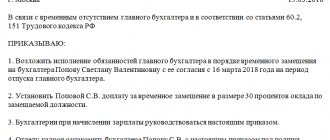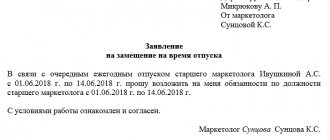Life circumstances and the Labor Code often provide for the possibility of an employee being legally absent from work for a long time. For example, an employee is on vacation, undergoing scheduled training, is ill for a long time, or goes on a long business trip - all this time he cannot perform his main duties. However, it is not always possible to simply leave work for a designated period of time; more often than not, stopping it is unprofitable, and then the employee needs a temporary replacement.
- How to register temporary performance of duties of a legally absent employee?
- How are such activities paid for?
- What points should not be overlooked?
Let us consider all these issues below and also help in drawing up the appropriate order.
Is it possible to conclude a fixed-term employment contract for the duration of the duties of an absent employee?
Acting Acting Person according to the Labor Code of the Russian Federation
Labor Code of the Russian Federation in Art. 60.2 talks about combining professions, increasing the number of assigned labor functions, expanding the zone of influence, and also separately notes issues related to the performance of the duties of an employee who is temporarily absent, but not released from work under an employment contract. This article was introduced into the Labor Code on the basis of Federal Law of June 30, 2006 No. 90-FZ.
Art. 151 of the Labor Code of the Russian Federation allows employees to agree to additional work offered to them in addition to their main responsibilities for an increase in pay.
HR officers usually understand by acting the performance of additional labor functions along with the main responsibilities in accordance with the signed employment contract, both for the same and for another position, providing additional remuneration.
Combining professions and increasing the volume of work
If the employer decides to increase the volume of work or assign responsibilities for filling another position to a subordinate, then three mandatory actions must be performed.
1. Offer additional work and obtain the employee’s written consent. Without official consent, an employee cannot be forced to work additionally. But there are exceptions. If the employment contract provides for the possibility of substitution, then special permission is required.
Sample proposal for additional work
2. Agree on the amount of payment. Labor legislation does not provide for restrictions on replacement pay. There is no minimum or maximum pay level. The amount of additional payment is determined by agreement.
3. Prepare personnel and administrative documents. Since the volume of work and remuneration are essential conditions of the labor relationship, it is necessary to consolidate the changes. Prepare an additional agreement to the employment contract. As well as an order to assign duties.
IMPORTANT!
During the period of replacement work, the employee is not relieved of his main duties.
Sample order on combining positions
Sample order to expand service areas
Reasons for introducing an employee as an interim employee
An employee's absence from work when a temporary replacement is required can be caused by various reasons:
- any leave (annual, maternity, at your own expense, for training, etc.);
- business trip;
- sick leave;
- assignment of public or government duties (election commission, employment as a jury, etc.);
- any other circumstances of absence from work, including those that have not been clarified.
Is it necessary to make entries in the work book about the performance of duties of a temporarily absent employee ?
Types of substitution
In order to most effectively ensure that the duties of absent employees are performed by the remaining employees, three ways are most often used:
- temporary transfer to another job;
- combination of positions, professions;
- increasing the scope of work or expanding the service area.
Let's consider how to arrange each of the options, and how the replacement of a temporarily absent employee is paid, in more detail.
During a temporary transfer, the employee is transferred to work in another position or profession. The person does not fulfill his obligations under his employment contract. For example, during the absence of the garage manager, one of the mechanics is transferred to his position.
Temporary combination is the performance during the working day, along with one’s duties defined by the employment contract, of additional work in another position or profession. For example, having sent a cashier on vacation, you can entrust his duties to an accountant on a part-time basis.
When the volume of work increases or the service area expands, the employee is assigned to carry out additional activities in the same profession (position) during the working day, along with his work. For example, if you have three service technicians, then during the absence of one of them, you can assign his duties to the remaining two.
Three things without which VRIO is impossible
In order for the replacement of an employee to be legal, three conditions must be met simultaneously.
- Written agreement of the parties. Without the written consent of the employee (additional agreement), the employer cannot involve him in replacing another employee.
- Organizational order. Any replacement option must be formalized by order of the head of the institution, carried out in the usual manner.
- Assignment of additional payment for additional work. The temporary replacement must be paid in addition to the regular remuneration of the employed employee. The amount is not specified by law; it can be calculated in any way convenient for the employer and to which the employee agrees.
FOR YOUR INFORMATION! The employee’s signature confirming familiarization with the order does not constitute a legal basis for issuing a replacement. An additional document is also required that specifically formalizes the consent of both parties, that is, both clauses 1 and 2 must be available, without excluding or replacing each other.
Surcharge
An employee, whether hired from outside or hired on a part-time basis, will not perform the duties of another employee for free.
When replacing, the worker has the right to count on additional payment - in accordance with Article 151 of the Labor Code of the Russian Federation. According to this regulatory act, payment in this case should be made on a contractual basis, but not less than what the main employee would receive for similar work, of course, in terms of working hours spent.
As for part-time work, a different payment procedure will apply here - in accordance with Article 285 of the Labor Code. The part-time worker must receive the same salary as the main employee - including allowances, bonuses, financial assistance, and so on.
Note!
The additional payment should be calculated depending on the working time spent.
Temporary replacement options
The Labor Code of the Russian Federation provides the employer with a choice of several possible ways to attract an employee to temporarily perform additional duties.
- On your own. Using the company's own resources, it is possible to assign additional labor functions to a willing and suitable permanent employee. An important nuance should be taken into account:
- if an employee has been assigned to perform exactly the same but additional duties in addition to his position, such a replacement will be carried out as part of expanding the service area or increasing the volume of work ;
- if an employee takes on responsibilities associated with another position, we will talk about internal combination .
- Translation on time. An employer can temporarily or even permanently change the job function of an employee called to replace an absent one (Article 72 of the Labor Code of the Russian Federation). You can change the position and/or structural unit to the one in which the employee in need of replacement worked.
- Moving. It can be applied if, as a result, the terms of the employment contract previously signed by the employee do not change (in this case, even his consent is not required). Thus, you cannot transfer to another location, to a different salary, etc., but you can, for example, transfer an employee to another machine, to another workshop, etc.
- Help from outside . If you cannot additionally load “your” employee, you can invite new personnel to temporarily replace them. Part-time work (internal or external) can be applied if a new employment contract is concluded, but in this case we are not really talking about temporary employment. A more universal way may be to conclude a fixed-term employment contract (Article 58 of the Labor Code of the Russian Federation).
IMPORTANT! The employer should soberly assess the employee's ability to perform additional work outside of his main position.
NOTE! In normal situations, the period for such a transfer within one organization usually does not exceed a year. But in cases specified by law, for example, when transferring to maternity leave, this period may be extended.
CHECK! If the employment contract clearly states the structural unit where the employee must work, then it is no longer possible to transfer him to another, even to an identical position, without his consent, since the terms of the contract change.
IMPORTANT TO REMEMBER! The validity period of such a clause cannot be indefinite; it will have to indicate either a specific date or the circumstances of its termination (usually indicate “until the departure of the main employee”).
Acting is not a part-time job!
Confusion may arise, since temporary replacement of an employee and part-time work have a common feature - both of these types of additional workload are performed by the employee, who at the same time must ensure that his main work is also completed.
The differences are as follows:
- The Labor Code regulates these types of additional employment in different articles: part-time work is considered in Art. 44 of the Labor Code of the Russian Federation, and VRIO - Art. 60;
- with part-time work, additional duties must be performed during times not occupied by the main work, and with temporary work, this occurs in parallel within the same working day or shift;
- for part-time work, a new employment contract is required; for temporary employment, written consent is sufficient;
- termination of a part-time job occurs only with the termination of the corresponding contract or the expiration of its term, and for temporary employment, cancellation is possible at any time (with a 3-day warning), both from the employer and the employed employee.
How to register temporary performance of duties by another employee
In any organization, people go on vacation, sick leave, go on business trips or for training. Therefore, there is often a need to replace one specialist with another. Which replacement method should the employer choose: combining positions, increasing the volume of work or temporary replacement? How to formalize the completion of such work and establish additional payment for it? Is it possible not to pay for it at all?
Step 1. Decide on the method of temporary performance of duties
The Labor Code provides for three ways for an employee to perform additional work without being released from the main one: combining positions (professions), increasing the volume of work (expanding service areas), and also performing the duties of a temporarily absent employee (Article 60.2 of the Labor Code of the Russian Federation). The named methods are united by the fact that additional duties are carried out without interruption from the main job and during the established duration of working hours (shift) (part one of Article 60.2 of the Labor Code of the Russian Federation). If such work is performed outside the working day, then it will be an internal part-time job (Article 60.1, part one of Article 282 of the Labor Code of the Russian Federation). The employer’s choice of the form of performance of additional duties depends on the nature of the work. In this case, it is necessary to take into account the features of each method.
Combining positions (professions) is the performance by an employee of additional work in another position (profession) (part two of Article 60.2 of the Labor Code of the Russian Federation). An employee cannot combine positions of the same name. Most often, combination is established when a staff position in an organization is not filled (vacant) for some reason. For example, a secretary, along with his work, can temporarily perform the labor function of a resigned personnel officer on a part-time basis until a new employee is hired for this position.
Attention! An employee may refuse to perform additional work ahead of schedule by notifying the employer in writing no later than three working days in advance (part four of Article 60.2 of the Labor Code of the Russian Federation)
An increase in the volume of work (expansion of service areas) is the performance by an employee of additional work in the same profession, but in an amount exceeding that established by the employment contract (part two of Article 60.2 of the Labor Code of the Russian Federation). For example, if a cleaner, working at one rate, must clean 80 sq. m of space, then, as part of an increase in the volume of work, she can be instructed to clean an additional 20 square meters. m during her main working hours. Of course, if she is able to cope with such a volume.
Fulfilling the duties of a temporarily absent employee is the performance by an employee of additional work in the same profession or in another (part two of Article 60.2 of the Labor Code of the Russian Federation). In this case, it is assumed that the replaced employee continues to be registered in the organization, but for some reason is not able to fulfill his duties. In other words, temporary replacement is allowed only for occupied positions and is not allowed for vacant ones. So, an engineer can temporarily perform the duties of a supply manager while he is on sick leave.
Attention! If the position that the employee will temporarily fill involves direct servicing of material assets, enter into an agreement with him on full financial responsibility (Article 244 of the Labor Code of the Russian Federation, Resolution of the Ministry of Labor of Russia dated December 31, 2002 No. 85)
It must be borne in mind that if an acting employee is released from his main job, then this is a temporary transfer to another job (part one of Article 72.2 of the Labor Code of the Russian Federation).
Step 2. Obtain written consent from the employee
Additional work on the basis of combining, fulfilling the duties of a temporarily absent employee or increasing the volume of work can be assigned to an employee only with his written consent (part one of Article 60.2 of the Labor Code of the Russian Federation). It can be expressed in an employee’s statement or formalized in a proposal for combination (increasing the volume of work, temporary replacement).
Step 3. We conclude an additional agreement to the employment contract
After receiving the employee’s consent, you need to draw up an additional agreement to his employment contract (part three of Article 60.2 of the Labor Code of the Russian Federation). It must indicate: the name of the position for which additional work will be performed, its content and volume; the amount of additional payment for combining positions (increasing the volume of work, temporary replacement); the period during which the employee will perform additional work.
If the combination of professions is due to the presence of a vacant position in the organization, then the term of work in the additional agreement can be formulated as follows: “The employee is entrusted with performing the duties of an accountant in the order of combining positions with an additional payment of 40 percent of the salary for the combined position from April 7, 2014 until the closure vacant position."
When performing the duties of a temporarily absent employee, when it is impossible to accurately determine the moment of his return to work, the additional agreement with the replacement employee can indicate: “The employee is entrusted with performing the duties of an accountant in the order of combining positions with an additional payment of 40 percent of the salary for the combined position from April 7, 2014 until the absent employee returns to work.”
Attention! If the manager does not formalize or pay for additional work in any way, he may be held administratively liable in the form of a fine of 1,000 to 5,000 rubles (Article 5.27 of the Code of Administrative Offenses of the Russian Federation)
Step 4. We issue an order for the temporary performance of additional duties
Based on the concluded agreement, issue an order for the temporary performance of additional duties (sample below). The document must indicate the work being assigned, the deadline for its completion and the terms of payment. Familiarize yourself with the employee’s order against signature (paragraph 10, part two, article 22 of the Labor Code of the Russian Federation).
Step 5. Set the surcharge
Despite the fact that labor legislation does not establish minimum and maximum amounts of additional payment for the temporary performance of additional duties, the employee must be paid for this work. The amount of additional payment is determined by agreement of the parties and depends on the volume and content of additional work (part two of Article 151 of the Labor Code of the Russian Federation). At the same time, the employer must remember his obligation to provide equal pay for work of equal value (paragraph 6, part two, article 22 of the Labor Code of the Russian Federation). The surcharge can be set either as a fixed monetary amount or as a percentage of the tariff rate (salary) or the employee’s salary.
The employer has the right not to pay for additional work if the employee’s employment contract or job description stipulates the obligation to combine his position with the position of a temporarily absent employee with a similar job function. Such a combination is considered to be performing work under an employment contract, and no additional payment will be accrued to the employee (letter of the Ministry of Health and Social Development of Russia dated March 12, 2012 No. 22-2-897, letter of Rostrud dated May 24, 2011 No. 1412-6-1).
Remember the main thing
Says: Larisa Gordeeva – head of the personnel department of LLC “Personal-Group T” (Tomsk):
– Temporary performance of additional duties without release from the main job is possible in three forms: combining positions (professions), increasing the volume of work (expanding service areas), as well as performing the duties of a temporarily absent employee. When combining positions, the employee performs additional work in another position; in case of temporary replacement, both in the same profession and in another. An increase in the volume of work involves working in the same position, but on a larger scale.
Ivan Uteshev – legal consultant of the Energogarant Insurance Joint Stock Company (Moscow):
– The employer must properly formalize and pay the employee for additional work. To do this, it is necessary to obtain the written consent of the employee, draw up an additional agreement to the employment contract and issue an order in any form. There is no need to make an entry in the work book about the temporary performance of additional duties, but this information can be entered into your personal card.
Milana Dubrovskaya – head of HR administration and personnel settlements practice at Adolex LLC (Moscow):
– The additional agreement to the employment contract must contain the following mandatory conditions: the method of assigning responsibilities to the employee to perform additional work (combining or expanding the service area, increasing the volume of work), a list of assigned work. And also the period during which the employee will perform it, the amount of additional payment.
Editorial staff of the magazine "Personnel Affairs"
How to draw up an order for an interim
IMPORTANT! A sample additional agreement to an employment contract for an interim employer from ConsultantPlus is available at the link
The specifics of the wording in the order depend on the chosen method of substitution. In general, an order for an enterprise must contain the following data:
- the names of the main position and the one accepted as part of the replacement;
- deadlines for completing additional work;
- the reason for the absence of the replaced employee, if established;
- basis for registration of replacement (number of the concluded additional agreement);
- the amount of the assigned additional payment;
- signatures of the parties on familiarization and agreement with the order.
How is additional payment calculated for a temporarily absent employee?
In accordance with the Labor Code of the Russian Federation, additional payment for a temporarily absent employee is accrued by agreement of the parties - the employer and the employee assigned to perform additional work. Thus, the amount of the surcharge and the procedure for its calculation can be fixed in:
- employment contract;
- collective agreement;
- The procedure for remuneration, or other documents regulating the mechanism for calculating and calculating wages and other monetary remunerations at the enterprise.
The amount of additional payment for performing the duties of a temporarily absent employee can be calculated either in a fixed form (the so-called “flat rate”) or as a percentage of the salary . Below we will look at the procedure for calculating surcharges for each method and look at an example.
Firm bet
At many enterprises, additional payment for a temporarily absent employee is calculated in a fixed form, namely in fixed monetary terms. In this case, the additional payment does not depend on the income of the absent or replacement employee, but is paid in the amount established by the employment/collective agreement.
In the case of an additional payment at a fixed rate, organizations use a gradational approach to determining the amount of payment in accordance with the complexity of the work performed, its volume, and level of responsibility. In other words, the amount of payment is set in different amounts, depending on the position of the replacing (absent) employee.
In addition, in large companies and large manufacturing enterprises with a complex and branched organizational structure, the amount of additional payment is fixed separately for each structural unit.
Substitution during vacation
Substitution during vacation is the transfer of an employee to the place of a vacationer (Article 72.2 of the Labor Code of the Russian Federation). Those. The employee does not perform his job duties while replacing the vacationer, but only performs the work of the employee who went on vacation.
The temporary transfer of an employee is formalized by a written agreement between the employee and the employer. Such an agreement can be made by analogy with a part-time agreement, replacing the information in it with information suitable for a specific situation (for example, indicating the amount of salary for the period of substitution, as well as information that during the period of substitution the employee performs only the work of a vacationer).
Who must sign an order to replace a temporarily absent employee
The order refers to those documents that always come from the top management of the enterprise.
Therefore, this document must be signed either by the director of the organization personally or by an employee who temporarily performs his duties. Also, all persons in respect of whom it was issued and those responsible for its execution must sign the order.
Thus, all the above-mentioned employees will testify that they are familiar with the order and are ready to carry it out.
Substitution by another employee
Most often, employers are faced with the need for a replacement suddenly, which greatly shortens the time to find a replacement. Therefore, they prefer to transfer the functions of the absent employee to another employee. This is permitted subject to the rules outlined in Art. 72.2 Labor Code of the Russian Federation.
Unfortunately, many employers shift some of the responsibility of absent employees to current employees without paying extra for it. This practice violates workers' rights. If someone else's job responsibilities have been imposed on you, remind the employer that he must pay extra for this. Moreover, in most cases, in order to transfer these powers, the employer must obtain consent from the employee who will be assigned these functions.
A conscientious employer must make the replacement in full compliance with the law . He must comply with the following rules:
- replacement by another employee of the enterprise is possible, but with an increase in the final salary (if part-time);
- the deputy may be charged with duties other than his position;
- the appointment of an employee to the role of a substitute is possible only with his written consent (except for the cases prescribed in paragraph 2 of Article 72.2 of the Labor Code of the Russian Federation);
- when registering a replacement, an additional agreement is drawn up if information about the replacement is not specified in the employment contract;
- there is a maximum duration of substitution (in emergency situations and without the consent of the employee - 1 year, in other cases these rules are prescribed in the internal regulatory documents of the organization).
All these rules indicate the rights and obligations of each party in the event of replacing one employee with another.
Is it possible to refuse a substitution?
An employer can place a person in another position during the absence of the main employee only after receiving written consent to do so from the replacement. However, there are exceptions to this rule. So, in para. 2 tbsp. 72.2 of the Labor Code of the Russian Federation states in what situations a person can be temporarily transferred to another job even if he refuses. This applies to the following situations:
- natural and man-made disasters;
- accidents that occurred at work;
- accidents that occurred during work;
- fires and fires;
- earthquakes;
- floods;
- strikes and hunger strikes;
- epidemics, as well as mass animal diseases;
- other situations in which there is a direct threat to the life of the population or its normal existence.
If any of this happens, the employer has the right to appoint another employee to the position. However, the duration of such a transfer cannot be more than 1 month. Moreover, the absence of indications of these duties in the employment contract does not exempt a person from fulfilling them.
When the absence of an employee has nothing to do with the listed circumstances, the employer has to negotiate with another worker so that he takes on additional responsibilities. Without this, it makes no sense to draw up orders and other internal documents. Moreover, coercion may entail administrative liability for the employer.
Registration procedure
So, the employee agreed to temporarily perform the duties of an absent employee. What should you do in this case? How to register a replacement for a temporarily absent employee? Step by step it will look like this:
- Obtaining written consent from the employee. The legislation does not establish a uniform form, so it is enough to write it on the organization’s letterhead and express your readiness to fulfill the duties of the absent employee. The document must reflect: information about the parties (employee and employer), the reason for the replacement and its duration, the position to which the employee is transferring (or holding a combined position). Next, the application is signed and the originator’s signature is affixed. If the replacement is related to emergency situations, this item is skipped.
- Drawing up an additional agreement. Its registration is necessary, since the main employment contract does not stipulate the terms of replacement. The additional agreement specifies what position the employee will hold and what functions are assigned to him. The terms of payment and the duration of such replacement must be specified here.
- Making a replacement order. It is imperative to specify in it who is replacing whom and for what reasons. The form of the order itself is no different from the one that is usually issued. It is possible to use the T-5 or T-5a form. After drawing up and signing the order, you need to familiarize the employee (if he agrees, he puts his signature). The document also specifies the terms of payment (tariff rate, salary or other forms of remuneration).
Download an application to replace a temporarily absent employee (sample)
replacement order
It is noteworthy that sometimes an employee is not transferred to the position of an absent employee, but is assigned an internal part-time job. It turns out that he simultaneously performs the duties of his own and temporarily assigned positions. Then all the nuances of the relationship are established on the basis of Art. 60.2 Labor Code of the Russian Federation. The registration itself occurs somewhat differently, since the person does not vacate his main position.
Termination of employment in a temporary position does not require the consent of the replacement, since such an appointment is temporary. At the end of the predetermined period, he returns to perform exclusively his duties, and the absent employee returns to his position.
If suddenly the main employee during his absence decides to quit completely, then the employer in his place can leave a temporary one performing duties (upon receiving his consent) or find a new employee. If the employee agrees, the additional agreement becomes invalid, and a new employment contract is concluded with him. It is usually assumed that such a person vacates his previous position. People most often react positively to such an offer; if the salary is higher, there are prospects for future growth.









